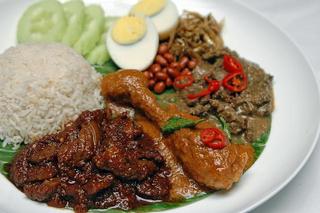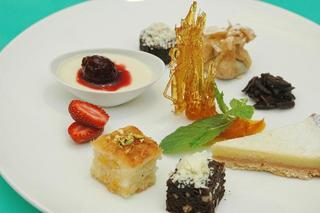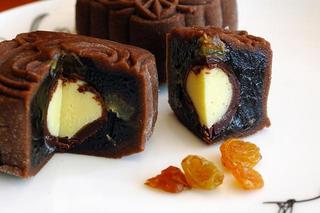
Tired of the local ‘kopi tiam’ for breakfast on weekends? Fancy tea and scones without paying a bomb? Head over Stan’s at One Bangsar.
You can have your Nasi Lemak Kukus (RM25) with the whole works – ‘sambal sotong’, ‘minang’ chicken and ‘tok’ beef for brunch. The huge portion of fragrant steamed Bario rice is richly flavoured with coconut milk and herbs and accompaniments of dry-fried peanuts, ‘ikan bilis’ (anchovies), cucumber slices and a hard-boiled egg. The ‘sambal’ is a little sweet, just the way how a good nasi lemak ‘sambal’ should be while the brown squid makes nice chewy mouthfuls. I did not quite take to the tender beef shin in an aromatic and mildly spicy gravy though and prefer the ‘minang’ chicken with its tongue-searing spiciness.
We can also vouch for the chicken broth noodles (RM19) – my kid quaffed the tasty chicken broth and ate most of the noodles laden with sliced shiitake and chicken without any fuss.
Breakfast at Stan’s Deli is served from 9.30 am to 11.30 am daily. For a late lunch or afternoon tea, you can expect wraps, salads, rice, light bites and scrumptious sweets – a concise menu of Stan’s best offerings that are both hearty and satisfying.
Stan’s Deli is really the ‘al fresco’ or outdoor section of the restaurant owned and managed by Stephanie Saw. Here the casual, idyllic ambience overlooks out onto a lush green garden setting and tinkling water features which is perfect to lounge over a leisurely breakfast or weekend brunch, enjoy afternoon tête-à-tête with bosom buddies and unwind after work over drinks with colleagues.
Saw explained that Stan’s main menu showcases her own interpretations of Malay and Asian recipes. “I tend to experiment with various ingredients, textures and flavours of traditional recipes and tweak them a little. I am targeting diners that are won’t mind sampling familiar dishes with a slight twist from the ubiquitous version. It is meant to intrigue them and give the dishes my own distinctive touch.”
The three salads we sampled bore testimony to her experimental touches – crabmeat with banana flower salad (RM18), tenderloin and mint salad (RM33), and prawn and mango (RM22).
Despite its unusual dressing of balsamic vinegar and olive oil, the salad of crabmeat, chopped banana flower, ‘daikon’ (Japanese radish), carrots and Spanish onions seemed rather heavy and uninspiring on the tastebuds. The interplay of flavours and textures also lacked punch.
The tenderloin salad fared slightly better with large, thin slices of seared tenderloin dressed in a piquant concoction of chopped galangal, mint, red chillies, shallots and lime juice and served on a bed of fresh romaine lettuce.
Stan’s prawn and mango salad is yet another departure from the usual ‘kerabu’-style salad. This creation consists of large, fresh prawns and shredded young mango tossed in a tangy aioli (a sauce made from
garlic,
egg and lemon juice). Thankfully the aioli dressing is light and zesty enough to pull the whole ensemble together.
For vegetarians, the assam pedas tofu mushroom noodles (RM16) will leave you replete. The robust dish of meehoon in mouth-watering sour and spicy gravy comes with soft Japanese tofu slices, shiitake and enoki mushrooms, pineapple slices and tomato wedges.
Rice lovers will relish the bario rice sets (RM23-RM26). A complete one-dish, well-balanced meal in itself, you can tuck into steamed bario rice with your choice of fiery ‘minang ‘chicken, ‘tok’ beef /chicken, or beef stew accompanied by ‘lengkuas’ squid (simmered in light coconut gravy flavoured with shallots, chilli, ginger and galangal), cucumber and long beans ‘ulam’.
If you like ‘roti jala’, then don’t miss sampling these lace pancakes with a choice of ‘minang’ chicken or lamb ‘maktom’ (RM10-RM12). It’s pure comfort food at its best! For something light, try the savoury prawn ‘botok’ (minced shrimp steamed in a spiced coconut mousse, RM12).
What’s afternoon tea without scones, profiteroles and cakes? Try the chocolate durian cake (RM12), a sinfully rich pairing that you either love or loathe. Personally I am not too enamoured although these two happen to be my favourite indulgences. Still, Saw told us lots of her customers can’t get enough of this decadent confection.
The banana cream pie (RM9) holds more appeal to me with the mini custard-filled shortcrust pastry shell brimming with slightly caramelized banana slices on top. Equally scrumptious was the dense butter marmalade cake with a scoop of vanilla ice-cream (RM9). I can't wait to return and have the scones, cream and durian profiteroles, pineapple upside down cake, carrot walnut and chocolate fudge cake.
Local sweets such as ‘seri muka pulut hitam’ (RM7) or ‘bingka labu’ (RM7) will go down well with ‘tong shui’ (sweet dessert broth) or sweet ‘bubur’– just ask the staff what is available for the day.
Stan’s Assam&Garam which is the actual restaurant premises has a more upmarket and contemporary ambience that incorporates dark wood paneling and raw, unfinished concrete flooring. The walls are adorned with framed ethnic ‘pelikat’ fabrics and intricate pieces of wood carvings while plush Afghan carpets, trendy wood veneer lampshades and a soothing water feature in one corner complete the entire setting.
Service can be a little erratic at times, with Saw having to keep an eagle eye on overall proceedings. The staff is generally friendly and helpful but occasionally, diners may have to be patient and bear with their inadequate grasp of English.
The restaurant itself seats about 70 persons but combine with the deli area, the capacity goes up to about 120. Group bookings for private events are accepted with prior notice.
You may have to splurge just a bit more when dining at Stan’s but be assured the quality of ingredients and food portions will more than make up for it.
STAN’S DELI&BAR
STAN’S ASSAM&GARAM (pork-free)
One Bangsar
Jalan Ara
Bangsar
Kuala Lumpur
Tel:22826286
Business hours- Daily Breakfast 9.30 am to 11.30 am (deli only)
Lunch 12.00 noon to 2.30 pm (late lunch available at deli)
Tea 3.30 pm to 6.00 pm (deli only)
Dinner 6.30 pm to 10.30 pm



 Tired of the local ‘kopi tiam’ for breakfast on weekends? Fancy tea and scones without paying a bomb? Head over Stan’s at One Bangsar.
Tired of the local ‘kopi tiam’ for breakfast on weekends? Fancy tea and scones without paying a bomb? Head over Stan’s at One Bangsar.


 Ipoh has always been famous for its silky smooth ‘hor fun’ (thin, flat rice noodles), crunchy beansprouts and delicious chicken rice. But if you are residing in KL and Selangor, why not enjoy these traditional Ipoh delights at Restoran Chan Thoong Kee?
Ipoh has always been famous for its silky smooth ‘hor fun’ (thin, flat rice noodles), crunchy beansprouts and delicious chicken rice. But if you are residing in KL and Selangor, why not enjoy these traditional Ipoh delights at Restoran Chan Thoong Kee?